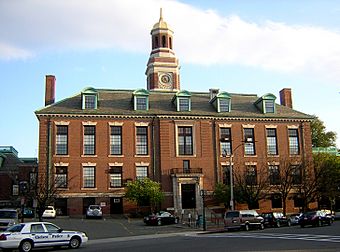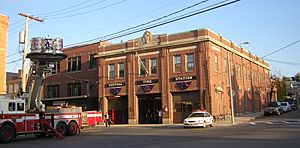Bellingham Square Historic District facts for kids
Quick facts for kids |
|
|
Bellingham Square Historic District
|
|

City Hall
|
|
| Location | Roughly bounded by Broadway, Shawmut, Chestnut, and Shurtleff Sts. Chelsea, Massachusetts |
|---|---|
| Area | 30 acres (12 ha) |
| Built | 1908 |
| Architectural style | Colonial Revival, Classical Revival |
| NRHP reference No. | 85000030 |
| Added to NRHP | January 3, 1985 |
The Bellingham Square Historic District is a special area in Chelsea, Massachusetts. It's like the city's main hub for important buildings and businesses. This district is mostly found around Broadway, Shawmut, Chestnut, and Shurtleff Streets.
What makes it unique is that most of its buildings were constructed after a huge fire in 1908. It shows how people planned carefully to rebuild the city. In 1985, this area was added to the National Register of Historic Places. This means it's recognized as an important historical site.
Contents
Chelsea's Heart: Bellingham Square
Bellingham Square is a busy spot where many streets meet. These include Broadway, Washington Avenue, and Bellingham Street. The historic district spreads out from this central point. It includes important city buildings, shops, and homes.
You can find the Chelsea Public Library here. There's also a part of Bunker Hill Community College. This college building used to be the city's post office.
A City Rebuilt: The Story of Chelsea
English settlers first came to Chelsea in 1624. It became part of Boston a few years later. In 1739, Chelsea became its own separate town. During the 1800s, it grew into a busy industrial city. It started with shipbuilding and then added other factories. In 1857, Chelsea officially became a city.
The Great Chelsea Fire of 1908
A huge event changed Chelsea forever. On April 12, 1908, a massive fire swept through the city. It destroyed the main business and civic areas. About 3,000 buildings were lost. The fire covered a huge area, about 500 acres.
Rebuilding with a Plan
After this terrible disaster, the state took charge of Chelsea. They started a modern plan to rebuild the burned areas. New rules were put in place for building. These rules covered zoning, construction, and fire safety. The way land was used in the affected areas was carefully planned.
Important architects helped design the new buildings. Peabody and Stearns designed the city's famous City Hall. Guy Lowell designed both the library and the post office. The city also built the Chelsea Free Hebrew School. It was designed by Samuel Eisenberg, a Jewish architect. This showed how the community came together to rebuild.




